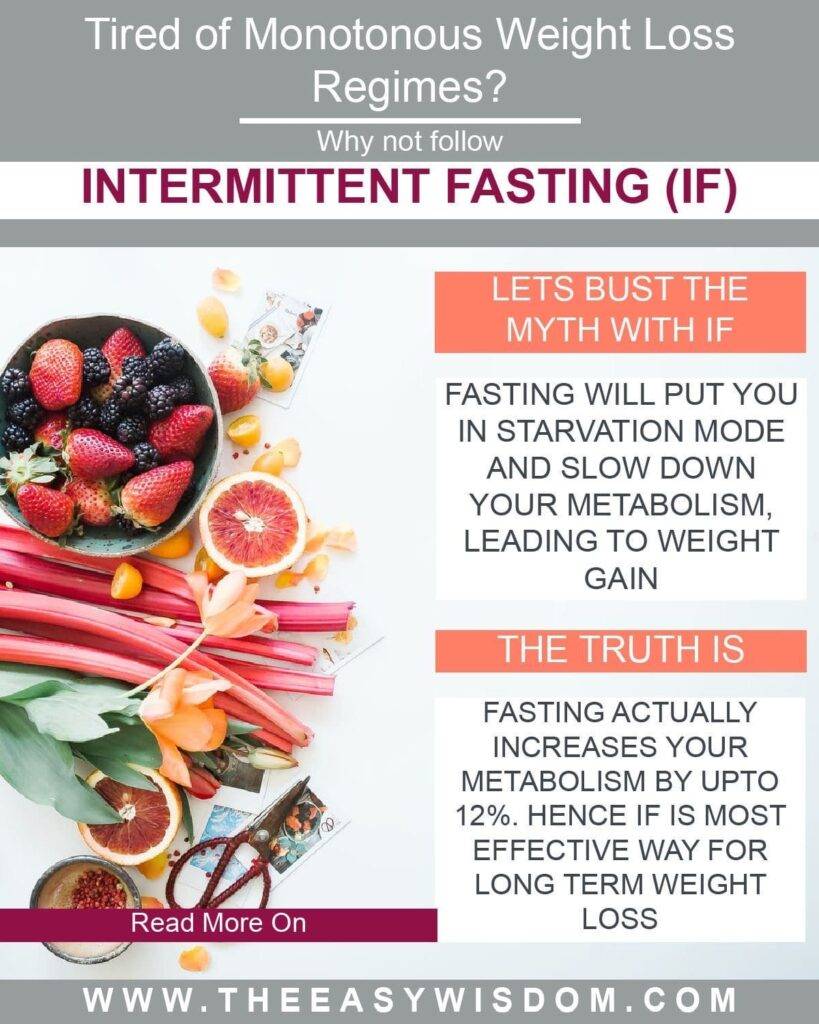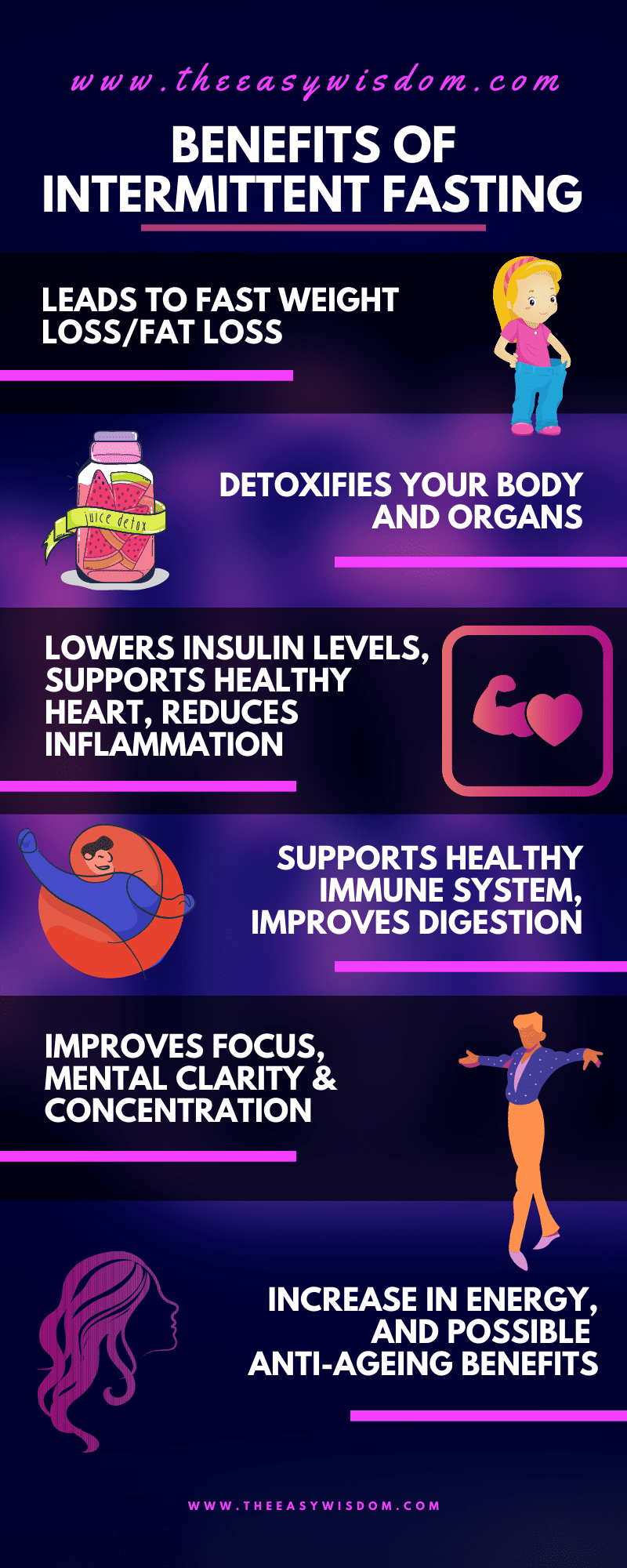In This Article
Yesterday I got a regular call from my best friend. The course of the conversation revealed that she is on an intermittent fasting plan that she now swears by. It helped her not only lose weight but also look younger!
A few days back, I found an article about intermittent fasting benefits. A few days later, I saw fashion diva Malaika Arora talking about how she
is religiously following the intermittent fasting plan and reaping all the health benefits.
I recently started on a new intermittent fasting plan, only to realize the immense benefits that intermittent fasting offers!
So what is this intermittent fasting (IF) that everyone is going crazy about? And what are the various intermittent fasting benefits?
Have you heard about intermittent fasting? I bet you do, but do you know what intermittent fasting is, its benefits, how to go about it, and what IF plans to follow?
Read on!
Intermittent fasting is not something new.
I observe fasts during Ramadan for one month every year. And you would be surprised to know that Ramadan fasting is a kind of intermittent fasting plan that Muslims follow religiously every year for a month.
Intermittent fasting is not something new. It has been there for ages, and only now its real benefits are being discovered.
So, now let us decode what is intermittent fasting, bust the common intermittent fasting myths, and deploy intermittent fasting to lead a healthy lifestyle.
Also Read: 5 healthy cooking experiments to do at home!
What is Intermittent Fasting?
Intermittent fasting is a lifestyle management program people follow to keep healthy and fit by alternating between periods of fasting and consuming food. It is a kind of eat-stop-eat program where you are allowed to eat for a limited time window and then fast for the next window. The length of the eating and fasting window depends on the kind of intermittent fasting plan you are in and your stage in the program.
A beginner can go for the 16:8 plan, that is, 16 hours of fasting followed by an 8-hour eating window. People at an advanced level can follow the 20:4 plan or the 24-hour stop-eat-stop plan.
The intermittent fasting diet focuses on the time you eat your food rather than what you eat. Your meals and snacks are limited to a specific time window in which you can eat anything. This window differs from person to person based on the type of plan they are following.

How does intermittent fasting help with weight loss?
Intermittent fasting for weight loss: The intermittent fasting plan works by metabolizing the body’s stored fat or reserves, called glycogen when the body runs out of carbs while fasting. Fasting helps us enter a state of ketosis—a state where our body burns fat. When you fast for longer hours, your body undergoes ketosis and starts to use your glycogen, and as a result, you lose weight. But this weight reduction mainly comes from fat loss and not muscle loss as IF depletes your glycogen or stored fat reserves.
The main reason intermittent fasting works amazingly for weight loss is that it helps you eat fewer calories throughout the day and then burn them off during the fasting window.
Sustainable long-term weight loss is one of the main intermittent fasting benefits you can realize very quickly!
Different kinds of intermittent fasting plans
There are five major types of intermittent fasting plans:
1. The 16:8 plan of intermittent fasting
The 16:8 is one of the most popular intermittent fasting plans. It is the easiest yet most influential of all the intermittent fasting plans for weight loss.
In this plan, you eat within an eight-hour window and then observe a 16-hour fast. This diet involves consuming food of your choice in any quantity during the eating window while following strict fasting during the fasting window. This plan usually involves skipping breakfast to maintain the fasting window. The sample 16:8 diet plan is given below in the table:

2. The 20:4 Plan of Intermittent Fasting
The 20:4 plan is a more difficult one where you get four hours of the window to eat and then fast for the next 20 hours. The sample 20:4 plan of intermittent fasting is given below in the table:

3. The 5:2 plan of intermittent fasting
The 5:2 plan of intermittent fasting requires you to fast for two days a week. The 5:2 diet plan involves consuming food in your routine for 5 days a week and then fasting for two days while restricting your total calorie intake to 500-600 during fasting days. This form of IF has also been the most popular one so far. The sample 5:2 plan of intermittent fasting is given below in the table:

4. The 24-hour fast (eat-stop-eat) plan of intermittent fasting
This method can be challenging as it requires you to fast for 24 hours at a stretch. It’s done just once or twice a week. Since it involves no food for a whole day, you can suffer from side effects such as low energy, fatigue, and headaches. Advanced-level intermittent fasting enthusiasts can easily follow this. The sample eat-stop-eat plan of intermittent fasting is given below in the table:

5. Fasting every alternate day plan of intermittent fasting
This plan involves fasting every second day. Your calories on fasting days are limited to 500-600 a day. You can choose to consume these calories in one meal or two. On non-fasting days, you can eat a regular healthy diet spread between four to six small meals a day. The sample fasting every alternate day plan of intermittent fasting is given below in the table:

Intermittent fasting diet plan
Intermittent fasting diet plan: what to eat and what to avoid?
Intermittent fasting does not restrict you to the choice and amount of food you can eat during the open window. But it is best advised to be conscious about what you eat during the eating window.
While overeating during the eating window can lead to digestion issues, and excess fat gets stored as glycogen, eating less than required can make you fatigued and nauseous during fasting.
So what should a typical intermittent fasting diet plan look like?
To make the most of your intermittent fasting plan, you should eat nutritious foods during the eating periods. Although there is no universal intermittent diet plan, including some food items while avoiding others can help you achieve your fitness goals.
What foods should you eat during the intermittent fasting plan?
- Unsweetened beverages or naturally sweetened beverages, such as natural fruit juices, etc., keep you hydrated and maintain your nutritional profile. Other beverages include plain water, black coffee, green tea, herbal tea, coconut water, buttermilk, lemon water, etc.
- Fresh fruits, such as avocados, as fruits, keep you fuller for longer.
- Vegetables and salads, especially the green ones.
- Whole grains such as buckwheat, barley, quinoa, oats, brown rice, etc. These grains are packed with protein and fibre and are your best friends during intermittent fasting.
- Lean proteins such as chicken, turkey, lean beef, eggs, cottage cheese or paneer, and fish to keep you fuller and healthier.
- Legumes such as kidney beans and lentils are particularly high in protein, mineral profile, and even fibre. They keep you full for long periods, keep your calorie count in check and keep your hunger pangs at bay.
What foods should you avoid during intermittent fasting?
You should certainly avoid food items such as processed, frozen, and packaged foods. Sugary foods and beverages should also be avoided at all costs. Another category of food and drinks to avoid is junk and convenience food items.
So these are a few tips about the intermittent fasting diet plan you should follow to make the best of your intermittent fasting efforts.
Intermittent fasting benefits
Intermittent fasting teaches you about restraint. It gives a glimpse of what it is to be hungry and, therefore, encourages you to eat when hungry. This is the basic principle behind the IF technique or intermittent fasting program.

There are various intermittent fasting benefits, including the following:
- Weight loss and fat loss, especially belly fat. There is less muscle loss than in other weight loss techniques with intermittent fasting.
- Detoxification of the body and organs due to fasting.
- Possible insulin resistance: IF can help reduce insulin resistance and lower blood sugar.
- Possible reduction in inflammation.
- Possible improved mental clarity and concentration.
- Possible increase in energy levels.
- Possible improvement in heart health.
- Possible anti-ageing benefits.
There are various intermittent fasting benefits. However, there are some side effects of intermittent fasting that you should know about.
Side effects of intermittent fasting
There are several intermittent fasting benefits but before starting the IF program, you should be aware of a few side effects of Intermittent Fasting.
The prolonged fasting hours and shorter eating windows can lead to fewer energy levels, mood swings, and unproductivity due to hunger and irritation. Being hungry for extended hours can also cause anger issues.
IF may also lead to excessive eating and binging during the eating window. This may cause excess calorie intake and problems related to indigestion and overnutrition. Your body may take some time to adjust to the new IF plan, but once the body gets attuned to IF, usually within 3–4 days of fasting, actual benefits can be reaped.
Myths associated with intermittent fasting
Here are a few intermittent fasting myths that you should know:
1. Fasting lowers the metabolic rate
Absolutely Not! Fasting doesn’t slow down the metabolism. Instead, blood levels and growth hormone increase with fasting. Higher levels of growth hormone mean more fat burning.
2. You can eat whatever you want when you break your fast
Absolutely Not! The quantity and quality of food make a remarkable difference to your health. Ensuring healthy and nutritious food goes a long way in reaping the potent health benefits of fasting. Eating too much after breaking the fast defies the entire purpose of fasting.
3. Working out while on intermittent fasting will make you weak
Absolutely Not! While on an intermittent fasting plan, it is advisable to indulge in any form of physical activity, the intensity of which may vary as per your nutrition and diet. It is advisable to work out during the eating window with a light meal to ensure you do not burn your muscles instead of fat.
4. It is unhealthy to skip breakfast
Not Really! The problem is that most breakfast skippers have unhealthy lifestyles. If you make sure to eat healthy food for the rest of the day, then the practice is perfectly healthy.
Intermittent fasting tips and tricks
Here are a few intermittent fasting tips and tricks you can leverage.
- Reduce your portion size and consume fewer calories to lose weight.
- Consume food during the 8-hour eating window in moderation.
- Focus on nutrient-dense, wholesome, fresh, healthy, and home-cooked foods while ensuring a healthy mix of proteins, carbs, and heart-healthy fats.
- Avoid junk, processed, frozen, and packaged foods at all times.
- Be hydrated by consuming water throughout the day, especially during fasting.
- Avoid sugar and focus on natural sources of sugar like whole fruits, dates, etc.
- Be consistent with your intermittent fasting diet plan while assessing your progress from time to time.
Make the best use of your intermittent fasting program by deploying the above-mentioned intermittent fasting tips.
Insider tips for intermittent fasting?
To make the best of the intermittent fasting benefits, you should keep the following in mind:
- Stay busy to divert your mind during the fasting window.
- Drink coffee or tea (without milk) if you feel hungry during the fasting window. Avoid dairy and sugars. Green tea is the best option.
- Do not binge after fasting.
- You may open your fast with dates and water, as the Muslims do during Ramadan. Open your fast gently with healthy and easy-to-digest food.
When to avoid intermittent fasting?
You should avoid intermittent fasting if you are:
- Underweight (BMI < 18.5) or have an eating disorder like anorexia.
- Pregnant – you need extra nutrients for your child.
- Breastfeeding – you need extra nutrients for your child.
- A child under 18 – needs extra nutrients to grow.
- You can probably fast under medical supervision if you have serious medical conditions like liver, kidney, or heart disease.
Recommended Read: 5 Natural Weight Loss Tips!
PS: Intermittent fasting results vary from person to person and are not a ‘one-size-fits-all’ method. As mentioned above, there are different kinds of intermittent fasting plans. You have to work with your nutritionist to decide what works best for you based on your health, lifestyle, physical activity, and goals. It is advisable to consult with your doctor before starting the IF plan, especially if you have a pre-existing medical condition.
If you like this post on “Intermittent Fasting Benefits: IF Plans, Tips, and Myths,” please share this with your family and friends.
You may also like to check out our YouTube Studio for some life-inspiring videos!




